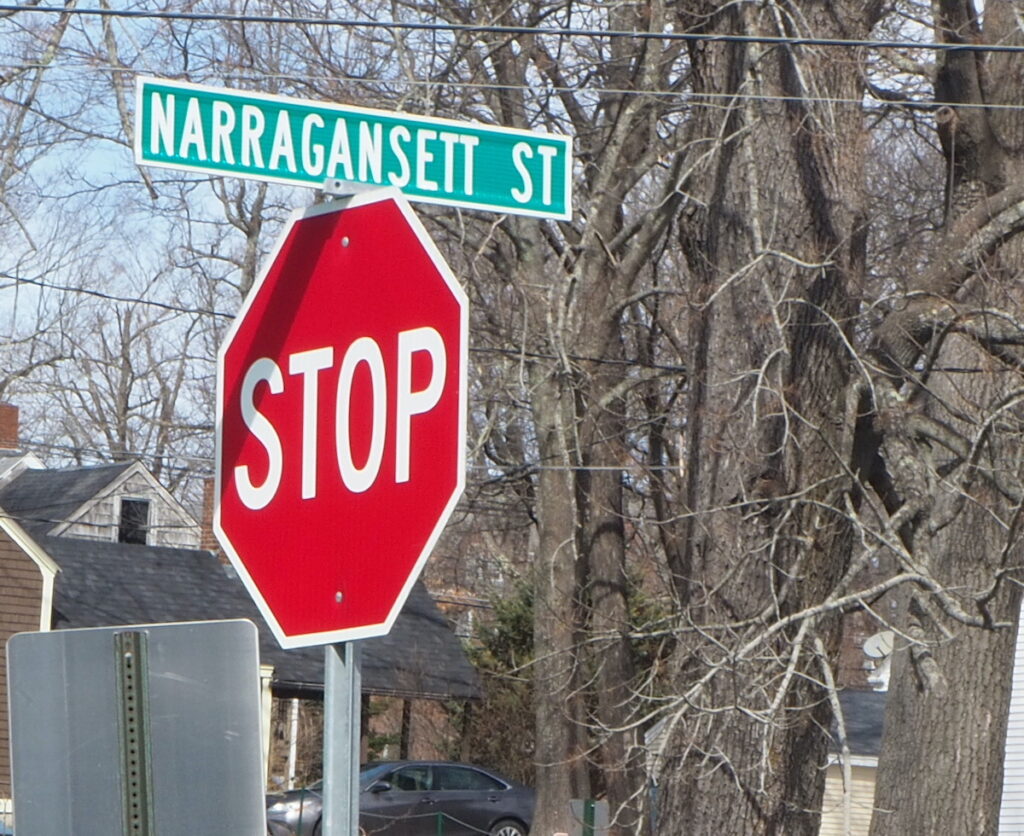
Narragansett Street in Gorham
In Gorham today, the word “Narragansett” is usually associated with the name of an elementary school, as well as a local street, Narragansett Street, and the stretch of U.S. Route 202 that runs from Gorham through Buxton is known as Narragansett Trail. However, there is a connection that has become obscured between these local Gorham names and a historic (yet still very much thriving) Rhode Island Native American tribe. Today, the survival of the Narragansett Tribe from the mid-1600s to the present day, where they are based on a reservation located within their historic homeland in Charlestown, Rhode Island, can be seen as an example of persistence and fortitude that readers may still learn from.
Some people in Gorham are aware that the town’s original name was “Narragansett Number Seven,” as it was one of seven “Narragansett Townships” created by the Massachusetts legislature in 1734 to honor militia soldiers who marched to Rhode Island to take part in the “Narragansett War” of the 1670s.
Others know that the town’s name was soon changed to Gorham to honor one of the town’s first colonial settlers, John Gorham, who was descended from militia members who fought the Narragansetts.
However, fewer people today are aware that the Massachusetts authorities chose the name “Narragansett Number Seven” to honor the colonial militia members who took part in a 1675 attack on the Narragansett people in their winter longhouses west of what is now Warwick, RI, in which over half of the tribe’s people were killed, including almost all their women and children.
After the Rhode Island legislature officially terminated their tribal status in the 1880s and sold off their reservation, they moved nearby as a group. They maintained their traditional tribal structures, official titles, and seasonal gatherings, despite the hostility of the state and many of their neighbors. A tribal renaissance began in the 1930s and 1940s when they published a newspaper for a while, began lobbying the legislature about land claims, and built a new longhouse. In 1975 they filed a land claim in federal court, and in 1983 they gained federal recognition and were awarded federal funds to re-purchase about 1400 acres of their previous reservation near Charlestown.
Below is a quote from US Representative Patrick Kennedy (D-RI), from a presentation he made to a Congressional committee. The speech was notable because Kennedy was one of the first of Rhode Island’s recent political leaders to acknowledge the terrible history of how the Narragansetts were treated by the region’s dominant [white] inhabitants for centuries and to publicly support the tribe’s efforts to gain full sovereignty rights (like those of other federally recognized tribes) and receive funding for purchasing land to increase the size of their reservation.
“Almost 400 years ago the Narragansett Tribe lived in peace. Before the European settlement of southern New England, the tribal government was the sovereign authority over their people and their general welfare. They educated their children, cared for their sick, and fished in the bay that now bears their name.”
From then to the present, the history of the Narragansett Tribe took place entirely in Rhode Island, far from Maine. Still, there is much that history can teach here in Maine about the Tribe’s resilience. They survived a brutal time in history, King Phillip’s War, The Great Swamp Massacre, the War of Independence, the French and Indian War, the Revolutionary War, and the Civil War, able to remain mostly neutral, which was important for their survival.
Although they were nearly decimated by colonial expansion and cultural conflicts, and their tribal lands reduced to a tiny fraction of what they once had, as of 2023, the Narragansett Tribe currently has about 2300 members, mostly in Rhode Island and neighboring states.
Learn more about the Narragansett tribe today by visiting their website, narragansettindiannation.org. For the reader’s interest, this article is provided in greater historical detail at the Gorham Times Website, https://gorhamtimes.com.


